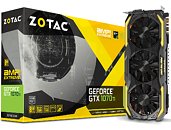Raevenlord
News Editor
- Joined
- Aug 12, 2016
- Messages
- 3,755 (1.18/day)
- Location
- Portugal
| System Name | The Ryzening |
|---|---|
| Processor | AMD Ryzen 9 5900X |
| Motherboard | MSI X570 MAG TOMAHAWK |
| Cooling | Lian Li Galahad 360mm AIO |
| Memory | 32 GB G.Skill Trident Z F4-3733 (4x 8 GB) |
| Video Card(s) | Gigabyte RTX 3070 Ti |
| Storage | Boot: Transcend MTE220S 2TB, Kintson A2000 1TB, Seagate Firewolf Pro 14 TB |
| Display(s) | Acer Nitro VG270UP (1440p 144 Hz IPS) |
| Case | Lian Li O11DX Dynamic White |
| Audio Device(s) | iFi Audio Zen DAC |
| Power Supply | Seasonic Focus+ 750 W |
| Mouse | Cooler Master Masterkeys Lite L |
| Keyboard | Cooler Master Masterkeys Lite L |
| Software | Windows 10 x64 |
NVIDIA's decision to prohibit AIB partners from factory overclocking their GTX 1070 Ti graphics is a decision that may not sit well with hardware enthusiasts, but it's one that makes the most sense from a business perspective. As it is, it's expected that overclocked versions of the GTX 1070 Ti graphics cards, which have come to offer a more compelling NVIDIA option against AMD's Vega 56 graphics card, will offer performance that is by all accounts comparable to that offered by its more expensive (and older) GTX 1080 graphics cards. So NVIDIA is just ensuring that its introduction of the GTX 1070 Ti with its $459 MSRP doesn't cannibalize sales of their higher tier graphics card through higher out-of-the-box performance via factory overclocking.

This generates some issues for AIB partners, since now they have one less data point to help them differentiate their products from competitor's: performance. The only indirect claim to performance they now have is through efficiency of their cooling solutions, but that's a cloudy metric at best; as such, companies are finding ingenious ways to avoid going up against NVIDIA's restrictions, while offering some differentiating factors to their GPUs.
Case in point, ZOTAC will be including, via their FireStorm utility, the ability for GTX 1070 Ti users to select from a cadre of performance profiles that are pre-programmed on the software suite - as opposed to being automatically applied from factory. This means that ZOTAC can comply with NVIDIA's clock demands, while offering users an easily observable way of increasing performance. It's expected that more AIBs will follow suit with this implementation. One example profile that ZOTAC will make available for their GTX1070 Ti AMP! Extreme graphics card unlocks 140% power limit (252 W) and a +150 MHz overclocking on base core clocks, raising the boost clock to 1833 MHz.

Of course, there's always the question of whether or not this actually affects enthusiasts - or most TPU readers - at all. We generally tend towards acquiring the lowest priced option with the best cooling solution so as to allow us to achieve, through manual overclocking, performance levels that AIB partners would never be able to implement on volume production hardware.
View at TechPowerUp Main Site

This generates some issues for AIB partners, since now they have one less data point to help them differentiate their products from competitor's: performance. The only indirect claim to performance they now have is through efficiency of their cooling solutions, but that's a cloudy metric at best; as such, companies are finding ingenious ways to avoid going up against NVIDIA's restrictions, while offering some differentiating factors to their GPUs.
Case in point, ZOTAC will be including, via their FireStorm utility, the ability for GTX 1070 Ti users to select from a cadre of performance profiles that are pre-programmed on the software suite - as opposed to being automatically applied from factory. This means that ZOTAC can comply with NVIDIA's clock demands, while offering users an easily observable way of increasing performance. It's expected that more AIBs will follow suit with this implementation. One example profile that ZOTAC will make available for their GTX1070 Ti AMP! Extreme graphics card unlocks 140% power limit (252 W) and a +150 MHz overclocking on base core clocks, raising the boost clock to 1833 MHz.

Of course, there's always the question of whether or not this actually affects enthusiasts - or most TPU readers - at all. We generally tend towards acquiring the lowest priced option with the best cooling solution so as to allow us to achieve, through manual overclocking, performance levels that AIB partners would never be able to implement on volume production hardware.
View at TechPowerUp Main Site
Last edited by a moderator:


 Wouldn't want to cannibalize on Pascal margins now would we
Wouldn't want to cannibalize on Pascal margins now would we

